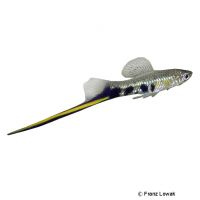Montezuma Swordtail (Xiphophorus montezumae)
| Montezuma Swordtail Xiphophorus montezumae | |
|---|---|
| Name | Montezuma Swordtail |
| Name Lat. | Xiphophorus montezumae |
| Family | Livebearers |
| Family lat. | Poeciliidae |
| Order | Killifishes & Livebearers |
| Order lat. | Cyprinodontiformes |
| Origin | Mexico |
| Habitat | Tributaries, streams |
| Diet | Omnivore |
| pH | 7.0-8.0 |
| Behavior | Peaceful |
| Keeping | Pair, group |
| Care Level | Easy |
| Reproduction | Livebearer |
| Breeding | Moderately difficult |
| Life Span | 3-5 years |
| Protection | No |
| Metric Units | |
| Size | 6-7 cm |
| Temperature | 20-24 °C |
| Hardness | 10-15 °dH |
| Aquarium | 120 l |
| US Units | |
| Size | 2.4"-2.8" |
| Temperature | 68-75 °F |
| Hardness | 178-267 ppm |
| Aquarium | 30 gal |
Distribution and habitat
Montezuma swordtails are native to northeastern Mexico, where they are found in the Rio Tamesi and Rio Panuco watersheds. They live in the current of the fast flowing rivers and streams.
Maintenance
The aquarium should have a varied, partly dense edge planting, with shelters and hiding places (roots) and provide sufficient swimming space. A sandy substrate and clear, medium to hard water as well as a medium to strong current is ideal.
No ammonia, ammonium and nitrite should be detectable, the nitrate value should not exceed 100 mg/l. To ensure the water quality and the oxygen content, a filter adapted to the aquarium size and a heater are required, as well as lighting for the species-appropriate day-night rhythm of the animals.
Diet
The food supply consists of live, frozen and dry food. For a balanced diet, feed once a day with a high-quality dry food (flakes, granules, pellets) as well as cyclops, daphnia or mosquito larvae (live or frozen). In addition, they need regular vegetable food, such as pureed leafy and wild vegetables, algae leaves or dry food with vegetable ingredients (e.g. spirulina)
It is recommended to feed small portions several times a day, which are eaten within a few minutes. A regular and varied diet promotes health and prevents deficiency symptoms.
Behaviour and compatibility
They are swimming and peaceful fish, also intra-species, and well suited for a community tank with other calm and peaceful fish. It is recommended to keep a group of at least 5 animals together, where the number of females should predominate.
Basically, only compatible fish species with similar demands on water conditions and water temperature should be socialized.
Sex dimorphism
Males are smaller and have an anal fin (gonopodium) that has been transformed into a mating organ. Sexually mature males bear a very long "sword" on the lower part of the caudal fin. Females are larger and appear rounder.
Reproduction and breeding
They are viviparous fish. Internal fertilization is provided by the male's gonopodium. Fertilized females are usually clearly recognizable by a dark colored pregnancy spot on the posterior abdomen. After 3-4 weeks of gestation, approximately 10-40 fry are born. They are already fully developed and independent at birth. After they have filled their swim bladder at the water surface, they can immediately start feeding.
Fry must be fed several times a day with special rearing food (Artemia nauplii). In community tanks breeding is hardly possible, because the fry are easy prey.
Important
Too soft water is not tolerated well in the long run
The well-being of the fish should be checked regularly. Temperature should be checked daily, pH, hardness and nitrate levels should be checked at least every 14 days. Regular partial water changes are recommended, even if the contaminant level has not yet reached the upper limit. Sudden changes in water quality should be avoided. Newly introduced fish must be accustomed slowly to the water in the aquarium.
Further literature can be found in your pet store.
References
Text: petdata; Image: Franz Lowak
Source: MELV (1998): Tierschutzgutachten - Haltung von Zierfischen (Süßwasser); BAENSCH & RIEHL (2004): Aquarien Atlas Bd. 4, Mergus Verlag; ENGELMANN (2005): Zootierhaltung - Tiere in menschlicher Obhut: Fische, Verlag Harri Deutsch
- Gemäß § 21 Abs. 5 Tierschutzgesetz idgF
